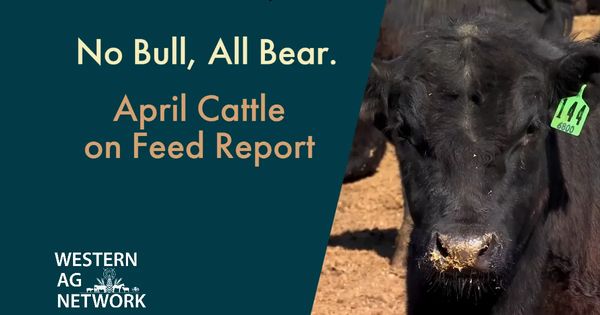.png?fit=outside&w=1200&h=630)
April 1 Cattle on Feed Down 4%
April 24, 2023
Cattle and calves on feed for the slaughter market in the United States for feedlots with capacity of 1,000 or more head totaled 11.6 million head on April 1, 2023. The inventory was 4% below April 1, 2022, USDA NASS reported on Friday.
The inventory included 7.12 million steers and steer calves, down 6% from the previous year. This group accounted for 61% of the total inventory. Heifers and heifer calves accounted for 4.50 million head, down 2% from 2022.
Placements in feedlots during March totaled 1.99 million head, 1% below 2022. Net placements were 1.94 million head. During March, placements of cattle and calves weighing less than 600 pounds were 390,000 head, 600-699 pounds were 310,000 head, 700-799 pounds were 540,000 head, 800-899 pounds were 517,000 head, 900-999 pounds were 175,000 head, and 1,000 pounds and greater were 60,000 head.
Marketings of fed cattle during March totaled 1.98 million head, 1% below 2022.
Other disappearance totaled 53,000 head during March, unchanged from 2022.
DTN ANALYSIS
"Friday's Cattle on Feed report will be viewed as neutral to somewhat problematic, as actual USDA figures were not what analysts had projected them to be," said DTN Livestock Analyst ShayLe Stewart. "Both the on-feed and placement data fell either outside or just within the bounds of analysts' estimated range, which could cause traders some grief on Monday.
"The biggest shock of Friday's COF report is the on-feed percentage landing at 96% of a year ago. With heavier placements than originally assumed, a greater percentage of cattle on feed is natural, but it's still not what the market anticipated. Compared to a year ago, the only states with greater year-over-year on-feed inventory were Idaho (up 5%) and Washington (up 13%). Meanwhile, when compared to a month ago, all the following states had greater placements than what they did 30 days ago: California (up 1%), South Dakota (up 2%) and Texas (up 1%).
"Friday's placement data was also startling, as analysts' placement estimates ranged anywhere from 91.5% of a year ago to 99% of a year ago; and Friday's figures came in at the absolute highest end of the spectrum. Compared to a year ago, these are the states that saw year-over-year increases: California (up 6%), South Dakota (up 26%), Texas (up 5%) and Washington (up 8%). Meanwhile, when compared to a month ago, there wasn't any state listed that didn't have greater month-over-month placements -- wow! The weight divisions that saw increases compared to a year ago were calves weighing under 600 pounds (up 10,000 head), and feeders weighing 700 to 799 pounds (up 5,000 head).
"But numbers are useless without any context, so now we must ask ourselves: Does this make any sense? And while I didn't expect Friday's numbers to be as heavy as they were, I can give merit to what the data presents largely because feed supplies are still tight, and most producers haven't had access to green grass just yet. USDA shared on a Daily Livestock Report update, 'Drought conditions have eased a bit, although they still remain problematic in key production areas. In its latest drought update, USDA noted that 41% of cattle in the U.S. were located in drought areas. Last year at this time, 60% of cattle were in drought areas. But the percentage of cattle in areas experiencing extreme drought or worse is still 18% compared to 21% last year.'
"And, secondly, given the sheer momentum the live cattle/feeder cattle market has had over the last month, buyers were eager to rush to sales and procure the cattle they needed for the months ahead. Throughout the first half of this year, the price spread between the May 2023 and August 2023 feeder cattle contracts has ranged anywhere from $10 to $25. Buyers that knew they had access to feed procured feeders wildly in March in an attempt to get ahead of the market before prices got any higher.
"In conclusion, Friday's April 1 Cattle on Feed report wasn't necessarily what the market expected, but it does align with what's developing throughout the countryside along with following some seasonal trends. Monday's market will likely be taken back by the report given that Friday's data surprised the market. But after a day or two of absorbing its content, traders should be able to look beyond this report. I'd call Friday's COF report neutral/somewhat bearish because traders react to where actual USDA numbers fall as opposed to where analysts projected them to be. And whenever there is any discrepancy between the two, traders usually react."
Source: DTN










